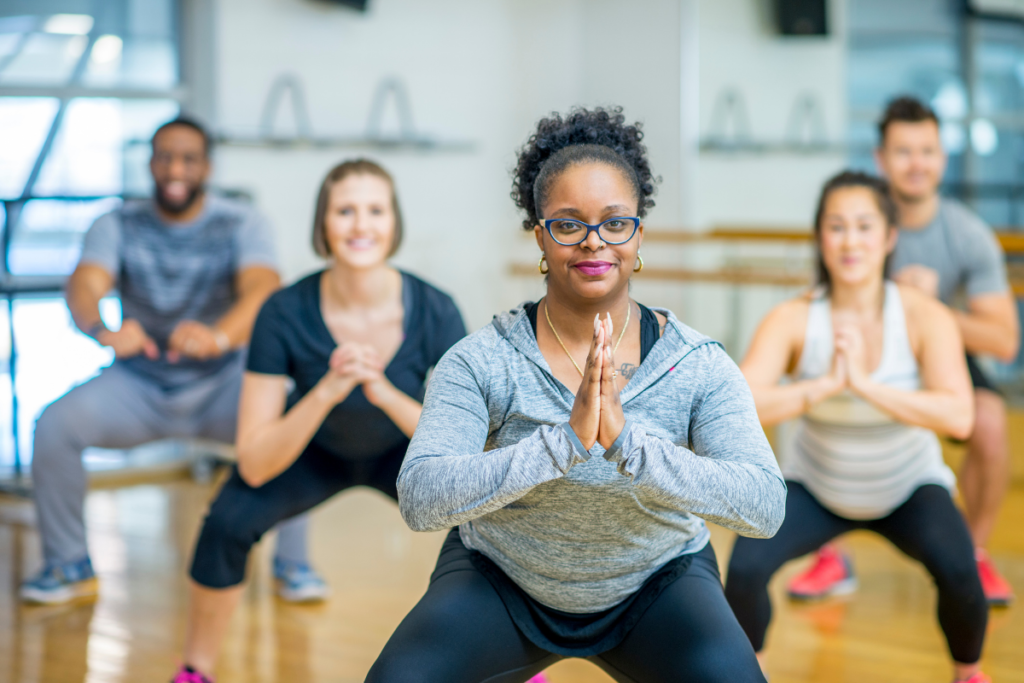Fitness Class as Experience

Is your fitness class just a schedule slot, or is it an experience?
People are ready to move and are seeking fitness class experiences that engage them on an emotional level. As a dedicated wellness leader, you know regular physical activity can do that. However, for new exercisers, taking a fitness class that’s designed to make it hard to get out of a chair the next day delivers the opposite effect.
Elevating your group fitness class to a wellness experience that engages newcomers and keeps them coming back for more is easy with the three tactics presented here.
Fitness Classes and Behavior Change
According to the transtheoretical model of behavior change—a health behavior readiness continuum used by health coaches and personal trainers to gauge a person’s readiness to adopt healthy lifestyle behaviors—beginners are at different levels of readiness to make change. Along with weak biceps and low cardiovascular endurance, new participants have fragile adherence skills that often include negative views about exercise. Newcomers typically find that working out triggers multiple reasons for giving up, including physical discomfort, negative self-talk, low self-confidence and a feeling that efforts aren’t producing results quickly enough.
It’s crucial to recognize that success with newcomers will increase if you provide an enjoyable, supportive experience that strengthens adherence skills and moves people in a positive direction along the behavior change continuum—all while they’re toning their triceps.
Jessica Matthews, MS, senior adviser for health and fitness education at the American Council on Exercise, in San Diego, and an expert on behavior change theory, agrees with this approach. “Regardless of the modality I’m teaching, I go back to the central theme of how do I make this single experience as meaningful and memorable as possible [for people], knowing that from a behavioral standpoint, I am laying the foundation for moving them along the continuum to [the place where] physical activity is part of their daily routines.”
Three Tactics for a Winning Fitness Class Experience
Help your students feel successful with these three tips.
One: Make It Approachable
To be encouraged to take action, new participants in the preparation stage of behavior change need experiences that feel approachable. These newcomers may be asking themselves, “Is it convenient? Will I be able to keep up? Will it hurt?”
I struggled to attract a consistent group of inactive seniors to my beginner class until I eliminated all the intimidating “fitness” words like “strength,” “strong” and “coordination” from the description. I created a new class called “Moving for Wellness” and structured the first few minutes as a check-in to connect with participants about their wellness goals and daily efforts. There was an immediate surge in both sign-ups and consistent attendance because the class now felt approachable.
See also: How to Name Your Group Fitness Class
Two: Personalize Your Class
Creating an experience that feels personal is crucial in the early stages of change. According to the ACE Health Coach Manual: The Ultimate Guide to Wellness, Fitness, & Lifestyle Change,“Rapport is an important determinant of adherence to an exercise program” (Bryant, Green & Merrill 2013). If you take the time to lay the foundation for a supportive and trusting relationship with a new student during the first few workouts, you may be able to minimize early-stage anxiety and create an important building block for improving self-confidence and motivation.
Robin O’Grady, owner of O’Grady Consulting in Calgary, Alberta, is a group fitness instructor who also runs an apprenticeship program for new instructors. She emphasizes the importance of arriving early, prepared to greet participants individually as they enter the room. She feels a particular obligation to her newer students. “Even just a smile or a bit of eye contact can change everything,” she says. O’Grady also builds rapport and trust by acknowledging and addressing any performance anxiety in new students with positive cues like, “Don’t worry if you’re going one way and we’re going the other. You can always catch up!”
Three: Add a Social Element
Social participation adds a fun factor and positively influences adherence skills such as motivation, self-confidence and relapse prevention. When beginners feel welcome and part of something special, they’re more likely to return. O’Grady stresses the importance of creating a “culture of inclusivity and community” in her classes from the very beginning. At key times of the year, when beginners are most likely to arrive, she coaches her regular members to be especially welcoming and supportive. “I tell them they are just as responsible as I am—if not more so—for helping beginners succeed,” says O’Grady. “Their reactions toward a newcomer could change that person’s experience for better or worse.”
Maybe it’s time to think beyond fun playlists and expert program design to ways we can make fitness feel as fun and inviting as a night out with friends—at least until it really is!
References
Wilson, K., & Brookfield, D. 2009. Effect of goal setting on motivation and adherence in a six-week exercise program. International Journal of Sport and Exercise Psychology, 7 (1), 89–100.
Meg Root
I am an ACE certified Group Exercise Instructor and Advanced Health and Fitness Specialist. I work as a wellness coach, speaker, and writer from my home base at Glen Ivy Hot Springs Spa in Corona, CA. I have worked in the spa industry for over 25 years, teaching and offering workshops at premier spas across the country including Rancho La Puerta, in Tecate, Mexico, The Oaks at Ojai, Green Valley Spa, in St. George, Utah, and The Spa at Sea Island, Georgia. I love working with a variety of populations, but I particularly enjoy reaching out to inactive and specialty populations with the message that "One SIMPLE ACT OF WELLNESS is all it takes to make you feel like your Well-Self again!" Please connect with me about my fun and interactive wellness workshops (including titles such as "I Know What I Should Do! I Just Need to Do It!" "Walking Toward Wellness" and "Writing Toward Wellness") which are perfect for employee wellness programs, wellness days, and small group wellness get togethers.





